Join this webinar to learn about wastewater drug testing and its implications for workplace safety. Register now!
Read more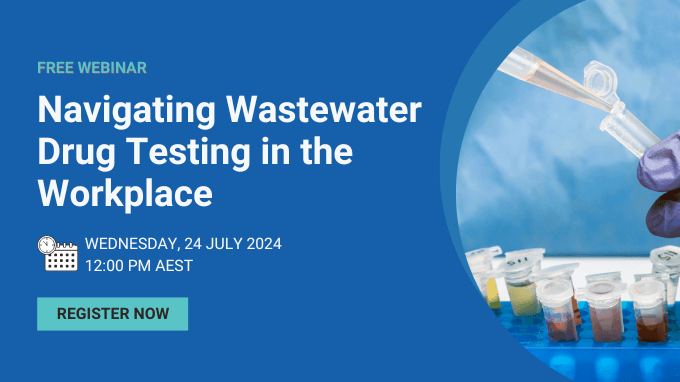
Join us on 24 July 2024 at 12 PM AEST for an informative webinar on wastewater drug testing and its implications for workplace safety and drug monitoring.
Can’t join live? Register to secure your spot, and we’ll send you the recording.
Webinar highlights
In this webinar, we will explore:
- Basics of Wastewater Drug Testing: Fundamentals of this innovative testing method.
- National Wastewater Drug Monitoring Program: Findings, trends & workplace relevance.
- Advantages and Limitations: Why wastewater testing is valuable yet cannot replace conventional drug tests.
- Case Studies: Real-world examples demonstrating the effectiveness of drug use reduction policies.
- Practical Tips: Guidance on integrating wastewater testing into your workplace program.
- Future Trends: Upcoming advancements in wastewater drug testing technology.
Don’t miss this opportunity to enhance your knowledge and improve workplace safety. Save your seat now!

Meet Our Webinar Speakers
Dr Phil Tynan, National Toxicologist
Dr Tynan, a renowned Toxicologist, and retired Clinical Biochemist Pathologist, offers a wealth of industry experience. He specialises in substance abuse testing, supports Safework Health in developing new assays and procedures, and provides expert advice to clients.

Nathan Brown, National Chief Scientist
Nathan, with over 20 years of expertise in toxicology, is the National Chief Scientist responsible for drug and alcohol tests in our NATA-accredited laboratories. Recognised as a leading authority in toxicology, he provides expert testimony to support medico-legal analytical results.
Meth residue testing is crucial before buying or renting a property to protect your health and investment.
Read more
Methamphetamine, also called ice or crystal meth, is a dangerous drug. It harms the people using it and can cause problems for property owners and tenants.
The production and smoking of meth can leave behind toxic residues that may not be visible to the naked eye but can cause health problems for future occupants. This is why meth residue testing is a critical service for anyone involved in real estate, whether buying, selling, or renting properties.
Let’s dive into why meth testing is essential and what it involves.
Understanding Meth Residue
Methamphetamine production and use release harmful chemicals into the environment. These substances can cling to walls, carpets, and even air ducts, creating an invisible threat. Long-term exposure to meth residue can lead to respiratory issues, headaches, and other health concerns, especially in children and pets.
Why Test for Meth Residue?
Protecting Health
The primary reason to test for meth residue is to ensure the health and safety of the inhabitants. By identifying contamination early, property owners can take the necessary steps to decontaminate and prevent exposure to these toxic chemicals.
Real Estate Transactions
When buying a property, you want to ensure that your investment is safe and free from hidden dangers. Meth testing as part of the home inspection process can give buyers peace of mind or serve as a bargaining chip if issues are discovered.
Landlord and Tenant Law
Landlords have a responsibility to provide a safe living environment for their tenants. Testing for meth residue is a proactive measure that can prevent legal issues down the line if tenants become ill due to undisclosed contamination.
How Meth Testing is Conducted
Meth testing involves taking samples from various surfaces within the property. These samples are then analysed in a laboratory to determine the level of contamination. Professional testing is recommended to get accurate results and ensure that the sampling process does not further spread contamination.
What to Do if Meth Residue is Detected
If a test comes back positive for meth residue, it’s crucial to undertake a thorough decontamination process. This should be done by professionals who specialise in hazardous material cleanup to ensure that the property is safe for future use.
Protect Your Health and Investment with Safework Health’s Meth Testing Service
Safework Health provides thorough methamphetamine testing services to safeguard against methamphetamine contamination. Using advanced, lab-based methods, we accurately detect methamphetamine and other amphetamines. As one of the few laboratories in Western Australia offering results within 48 hours, we ensure quick and efficient testing, enabling prompt corrective action.
If you suspect that your property or workplace may have been exposed to methamphetamine use or production, don’t hesitate to contact Safework Health today.
Watch this video to learn about workplace drug and alcohol testing.
Read moreDrug and alcohol testing in the wokrplace is crucial to maintaining safety, productivity, and compliance with legal regulations.
Whether you’re an employer looking to implement a drug testing program or an employee seeking information on your rights and responsibilities, this video will provide you with the essential information you need to navigate the complexities of workplace drug testing.
Unlock the potential of hair follicle drug testing with our informative infographic.
Read moreHair follicle drug testing offers a comprehensive and reliable method for detecting long-term drug use patterns. This infographic provides an understanding of its principles, applications, and implications, empowering informed decisions in various contexts such as employment screening and legal proceedings.
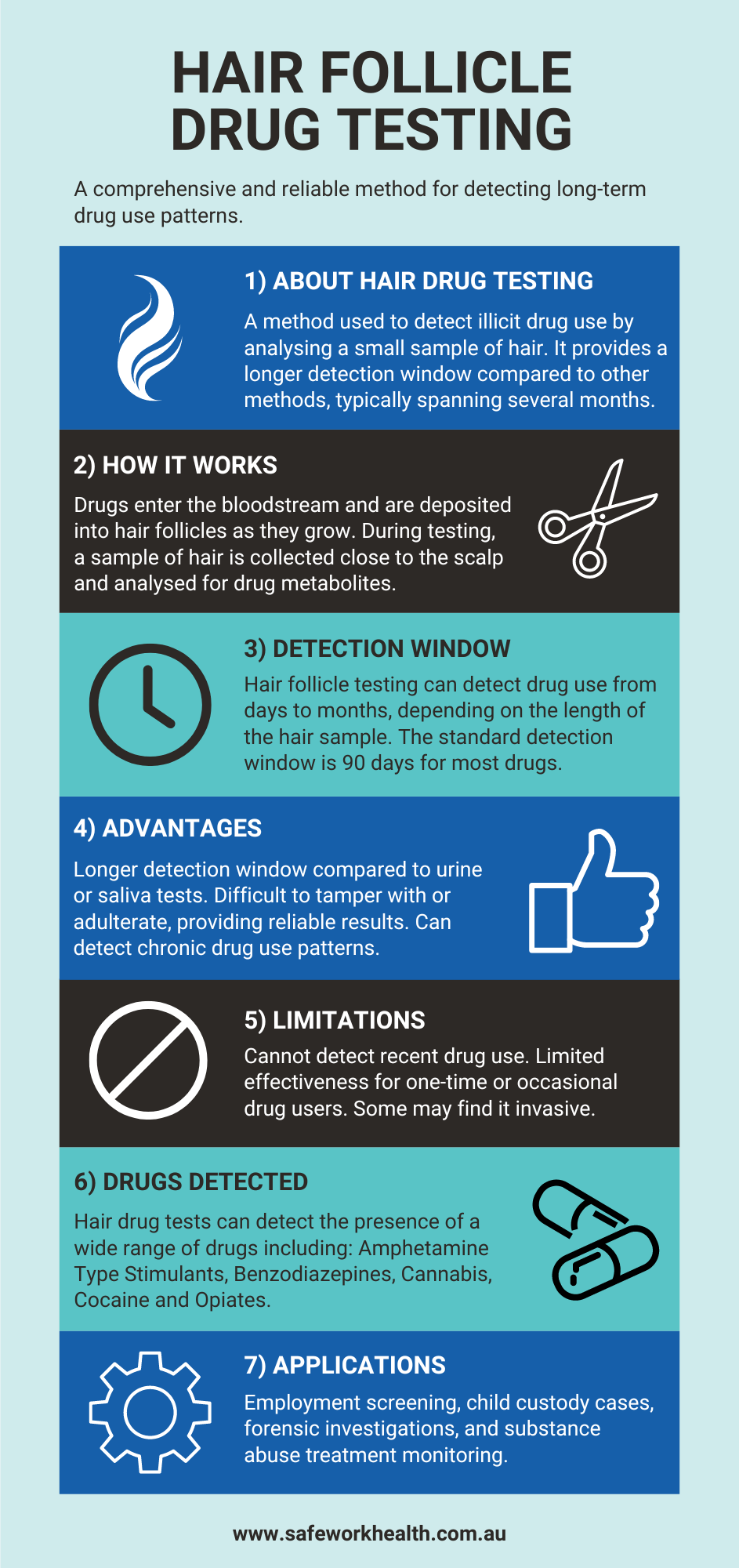
Unlock the power of hair follicle drug testing for family law.
Read more
In the realm of family law, particularly in cases involving child custody battles or allegations of substance abuse, the need for accurate and reliable drug testing methods is paramount.
Among the various options available, hair follicle drug testing stands out for its ability to provide a comprehensive history of drug use. As a family lawyer, having a solid understanding of hair follicle drug testing can be invaluable in building your case and advocating for your clients.
In this guide, we’ll address common questions family lawyers may have about hair follicle drug testing.
1. What is Hair Follicle Drug Testing?
Hair follicle drug testing is a method used to detect the presence of drugs in a person’s system by analysing a small sample of hair follicles.
Unlike other forms of drug testing, such as urine or oral fluid tests, which provide a snapshot of recent drug use, hair follicle testing can detect drug use over a longer period, typically up to 90 days.
2. How Does Hair Follicle Drug Testing Work?
When a person consumes drugs, traces of these substances are absorbed into the bloodstream and eventually deposited into the hair follicles along with other nutrients.
During hair drug testing, a hair sample is collected from the individual’s scalp, usually from the root end, and sent to a laboratory for analysis.
The laboratory then processes the sample using techniques such as Liquid Chromatography/Mass Spectrometry (LC/MS) to detect the presence of specific drugs or their metabolites.
3. What Drugs Can Hair Follicle Testing Detect?
4. Is Hair Follicle Drug Testing Reliable?
Hair follicle drug testing is highly reliable when conducted by accredited laboratories using validated methods.
Unlike urine tests, which can be susceptible to adulteration or substitution, hair follicle testing is difficult to tamper with, making it a preferred option in many legal contexts.
However, it’s essential to ensure that the testing laboratory follows strict quality control measures and employs certified technicians to maintain the integrity of the results.
5. Can Hair Follicle Testing Determine the Timing of Drug Use?
While hair follicle drug testing can provide a historical overview of drug use over several months, it cannot pinpoint the exact timing of drug consumption with precision.
Factors such as the rate of hair growth and the length of the hair sample collected can affect the interpretation of results. Additionally, external contamination from environmental exposure to drugs can sometimes lead to false positives.
Therefore, it’s essential to consider these limitations when interpreting the results in a legal context.
6. How Can Hair Follicle Drug Testing Benefit Family Law Cases?
In family law cases, especially those concerning child custody disputes or allegations of substance abuse, hair follicle drug testing can serve as compelling evidence to substantiate or challenge claims made by either party.
With its extended detection window spanning up to 90 days, hair testing provides a more comprehensive depiction of a parent’s drug use behaviour over time. This detailed understanding can significantly impact custody decisions or visitation rights, offering courts a clearer insight into the parent’s ability to provide a safe and stable environment for the child.
Safework Health: Your Trusted Hair Testing Partner
Safework Health, as a leading provider of hair follicle drug testing services, prioritises strict adherence to chain of custody procedures to uphold the reliability and credibility of our results in legal proceedings.
With a nationwide network of NATA-accredited laboratories, we guarantee meticulous analysis of hair samples for traces of drugs, providing accurate results backed by rigorous testing methodologies.
Our commitment to delivering swift outcomes within 7 to 10 working days empowers family lawyers to make well-informed decisions efficiently in cases involving substance abuse allegations.
Contact Safework Health today to discover how we can support you in promoting a safer and healthier environment for families.
Explore AS/NZS 4308:2023, reshaping workplace drug testing. Uncover vital changes impacting your program for effective compliance.
Read more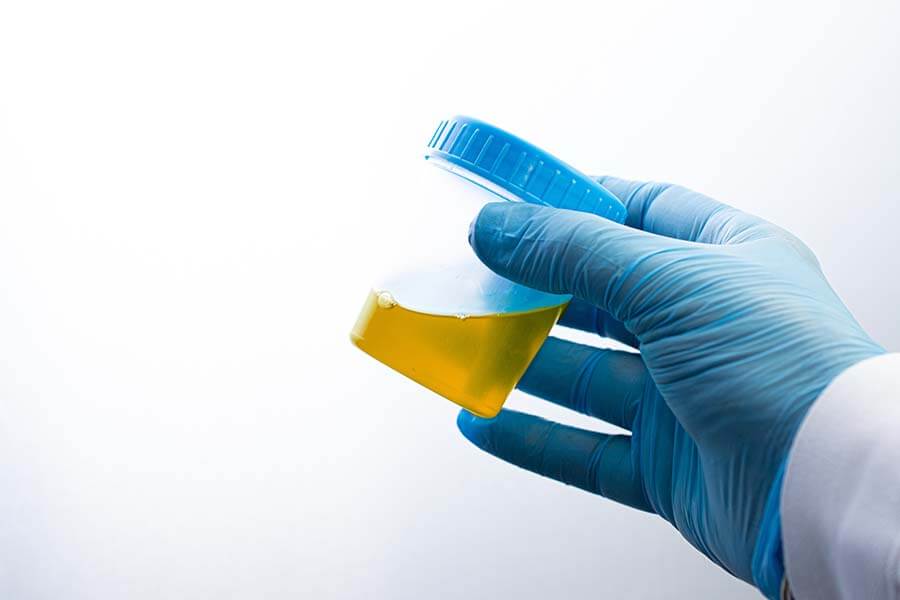
Introducing the latest benchmark in workplace urine drug testing: AS/NZS 4308:2023. This new standard marks a significant departure from its predecessor, AS/NZS 4308:2008, bringing about key changes that have implications for your workplace drug testing program.
Delve into the details to better understand the modifications and their impact on your workplace.
About AS/NZS 4308:2023
AS/NZS 4308:2023 sets the benchmark for procedures concerning urine specimen collection, storage, handling, onsite drug screening tests, and dispatch to a laboratory. It’s a vital resource for maintaining best practices in drug testing.
Unveiling 3 Key Shifts in Workplace Drug Testing
- The first key change is a DECREASE in the screening cut-off for cocaine metabolites, from 300 ug/L down to 150 ug/L, and a corresponding drop in the confirmatory cut-off from 150 ug/L down to 100 ug/L. This should result in more detections on-site, along with confirmatory testing being more likely to match the initial screening result.
- The second key change is a DECREASE in the confirmatory cut-off levels for Benzodiazepine metabolites, from 200 ug/L down to 100 ug/L. This will reduce the likelihood of a non-negative on-site screen returning a confirmed negative confirmation due to a mixture of metabolites being present in the urine with no individual component over 200 ug/L. Screening cut-offs for Benzodiazepines remain at 200 ug/L.
- The third key change is allowing laboratories to report parent/metabolite drug(s) that are detected below the cut-off, but between the laboratories limits of quantitation (LOQ) and the cut-off, where another drug/metabolite has been detected above the cut-off. For example, when amphetamine is detected in a sample and a low level of Methamphetamine is present, that Methamphetamine result will additionally be reported to aid in the interpretation of results.
Other minor changes/additions include:
- Expanded reference to Informed Consent in relation to scope of testing.
- Centralised QC testing of devices at the main storage site, as opposed to on -site prior to testing.
- Allowances for Liquid Chromatography Mass Spectrometry (LCMS) based screening of drugs, with cut-offs as per confirmatory methods.
- Oxycodone has specified cutoffs for screening and confirmation, but is not included in the main testing panel.
Cut-Off Levels for THC Remain Unchanged
There are no changes to the testing process for THC in the urine standard. All cut-offs remain the same.
Implementation Timeline
AS/NZS 4308:2023 also introduces a crossover period for 3 years where both standards are in effect, allowing manufacturers, laboratories, and collection agencies to implement changes when devices, laboratory procedures and processes have been updated to meet the new requirements.
Discover More
A Safework Health representative is available to discuss the upcoming changes and the proposed timeline for implementation. Contact our team today!
Explore the impact of fentanyl and oxycodone in Australia, uncover evolving trends, and discover workplace testing methods.
Read more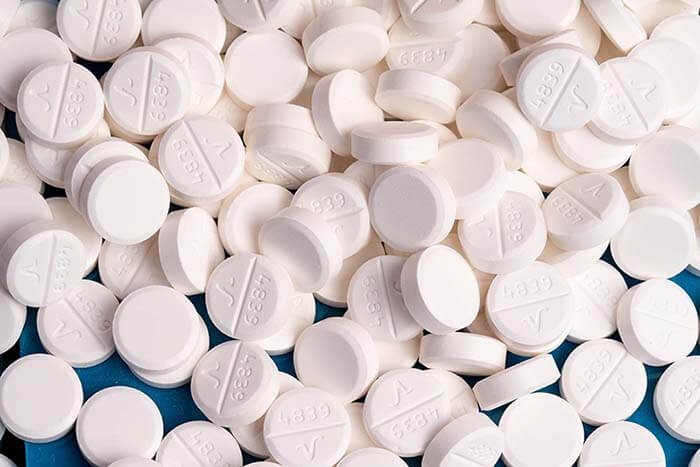
Fentanyl and oxycodone, the key players in the opioid epidemic sweeping across the United States, have begun to reshape the landscape of opioid use in Australia. While usage rates here remain lower than in the US, recent studies reveal a shift in opioid consumption patterns.
In this engaging article, we delve into the world of fentanyl and oxycodone, exploring their impact on Australia, tracing the evolving usage trends, and shedding light on effective workplace testing methods for detecting their presence.
Fentanyl vs Oxycodone
Fentanyl and oxycodone are powerful and highly addictive opioids commonly used for pain management.
What is Fentanyl?
Fentanyl is a synthetic opiate drug that is 80 to 100 times more powerful than morphine.
It is used medically as an intravenous anaesthetic and analgesic. However, it is most often encountered as a transdermal (skin) patch to relieve long-term pain, or to supply relief to cancer patients and the elderly. The drug is often misleadingly marketed as ‘safe’.
These patches are frequently discarded when they are around two-thirds used as the quality of pain relief tends to drop over time. Unfortunately, these ‘used’ patches can be reused by addicts when they extract the fentanyl gel. This practice is called ‘dumpster diving’ because they often search for old patches in the garbage. They then distil the pure drug from the patches and often recrystallise the drug to form “Rock.” Fentanyl distillates can be smoked, or the patches can be used directly – either being pasted on the body or chewed.
Traditionally fentanyl powder is often mixed with low-quality heroin. Heroin supplies from Central Asia are drying up. This is pushing users to experiment with fentanyl.
Additionally, increasing amounts of fentanyl are being imported into Australia. Just last year, the Federal Police in Melbourne seized a shipment of fentanyl equivalent to 5 million individual doses.
What is Oxycodone?
Like fentanyl, oxycodone is a synthetic opiate often sold as Oxycontin or Endone which, when taken by mouth, is one-and-a-half times more potent than morphine.
Medically, it is used for managing moderate-to-severe acute or chronic pain and is normally sold as a controlled-release tablet to be taken every 12 hours. As with all opioids, oxycodone induces euphoria and is addictive.
Oxycodone is one of the most abused pharmaceutical drugs in the US and is significantly abused in Australia, although not (as yet!) at levels approaching those in the US.
Once a person becomes physically dependent on oxycodone, they experience strong cravings for the drug, leading to continued use despite the ongoing physical harm. They are also at risk of suffering severe withdrawal symptoms, which can include panic attacks, nausea, muscle pain, insomnia, and flu-like symptoms.
Overdoses can easily be fatal. When not fatal, they can cause spinal cord infarction and ischaemic brain damage that resembles a bad stroke. Oxycodone also interacts badly with many other prescribed drugs – especially some anti-HIV medications – which can substantially slow the rate of clearance of the drug from the body.
Combining Opioids With Stimulants
Oxycodone and fentanyl are now being increasingly used in combination with stimulants – especially of the amphetamine class (which includes Meth).
There is a long history of people combining opioids with stimulants, such as ‘goofballs’ combining methamphetamine with heroin and ‘speedballs’ which are a heroin plus cocaine mixture. Australia already has a widespread Meth problem, and the number of cases where opioids were combined with Meth is rising.
Oxycodone and Fentanyl Usage Trends in Australia
There is a growing opioid abuse culture in Australia.
Even in 2008, the National Drug & Alcohol Research Centre reported that 91% of injecting drug users in Australia report having used Oxycodone. 23% admitted to using it in the last 6 months.
Fentanyl use has been rising in Australia, especially over the last 4 years – most notably on the Sunshine Coast in Queensland. Programs to stop fentanyl use have been only partly successful as addicts often switch over to oxycodone.
Oxycodone and fentanyl use in Australia is substantially higher in regional areas than in urban and capital areas, but the overall use rate is significant in both areas.
Worksite drug testing has shown that the use of these drugs varies substantially over the week. In remote sites, importation may occur only on specific days – which is then reflected in higher capture rates over the next 24-48 hours.
Cracking down on one opioid – such as oxycodone – only appears to encourage users to switch to another opioid: specifically, fentanyl. This was seen in the closing years of the last decade in Queensland where a crackdown on oxycodone led to a rise in fentanyl abuse.
Surging Popularity of Fentanyl and Oxycodone: Examining the Pros and Cons
What is the danger if oxycodone and fentanyl use are on the rise?
Both fentanyl and oxycodone carry a high risk of making users dependent on the drugs, and both have what is called a narrow therapeutic window: a dose sufficient to bring on a high is not much less than the dose required to give a potentially lethal overdose.
The appeal of fentanyl and oxycodone is that the drugs are pharmaceutical – so they have a high purity, and users are less worried about contamination. The drugs are highly potent – ‘more bangs for the buck’ – and because of their rapid uptake cause a ‘quick high’ (especially fentanyl).
The advantage from a medical perspective is that fentanyl can be taken when a patient has an impaired liver, to treat neuropathic pain, and the patches can be used when a patient is nauseous, vomiting or has difficulty swallowing. For the user, the big attraction is that fentanyl is the fastest-acting opioid available.
Fentanyl is cheap – so it is a popular opioid for abuse. Unfortunately, it also has the most prolonged respiratory depression (suppression of the breathing reflex) of any opioid – which arguably makes it the most lethal.
Workplace Drug Testing: Detecting Oxycodone and Fentanyl Use
Common workplace drug testing methods include:
- Urine Drug Testing – Oxycodone and fentanyl can be detected in a specifically requested assay in urine. Urine is the superior sample for both drugs, as the detection window is much greater than oral fluid – up to 4 days.
- Oral Fluid Drug Testing – Oxycodone is included in routine oral fluid screening tests, unlike fentanyl which is not included in these tests. The detection window for oral fluid is 36 hours.
- Wastewater Drug Testing – Wastewater drug testing is the best way to get a snapshot of the extent of actual opioid use at a workplace but should include weekend coverage as use varies greatly day-to-day.
Safework Health: A Leader In Workplace Drug Testing
Safework Health stands out as one of the select few laboratories in Australia capable of conducting urine testing specifically for oxycodone and fentanyl.
Plus, we offer a verified onsite urine drug screening device that can detect Fentanyl, Oxycodone and Ketamine.
Feel free to reach out to us today for a discreet and confidential consultation.

Meet The Author
Dr Phil Tynan, National Toxicologist
Dr Tynan, a distinguished Toxicologist and a retired Clinical Biochemist Pathologist, brings a wealth of industry knowledge and experience. He is considered an expert in testing for substances of abuse.
Dr Tynan primarily supports Safework Health in developing new drug assays and procedures. He also offers guidance to clients and expert clinical advice as needed.
Dr Tynan is a published toxicologist in internationally peer-reviewed journals and is available to provide advice and expert opinion regarding results, expert witness testimony and appearances at courts and tribunal hearings.
Urine drug testing is the most common drug testing method used in occupational health.
Read more
A urine drug test, or urine drug screen (UDS), is the most common method of workplace drug screening in Australia.
Many employers prioritise the safety and well-being of their employees by employing this method due to its speed and accuracy in detecting drug traces in urine samples.
A urine drug test aids both employers and employees in preventing hazardous situations that could potentially lead to accidents and fatalities.
What Drugs Does a Urine Drug Test Detect?
Employers in Australia typically request a standard drug screen, which includes screening for cannabis, cocaine, benzodiazepines, amphetamines, and opiates – five of the most abused drugs. This is commonly known as a five-panel drug test.
Pros And Cons Of Urine Drug Testing
While urine drug testing has its advantages, it’s important to note that each method has its own strengths and limitations.
The choice of testing method should be based on factors such as the specific drugs being tested for, the detection window required, the ease of sample collection, and the overall testing goals.
Advantages of a Urine Drug Test
- Wide Detection Window: Urine testing typically has a longer detection window compared to saliva testing. Drugs and their metabolites can be detected in urine for a more extended period, making it suitable for detecting past drug use.
- Ability to Detect a Wide Range of Substances: Urine testing can detect a broader range of substances compared to saliva testing, making it a preferred choice for comprehensive drug testing panels. It can detect both drugs and their metabolites.
- Cost-Effective: Urine drug testing is often more cost-effective than hair testing, which can be more labour-intensive and expensive to process.
- Immediate Results for On-Site Testing: For on-site testing, urine tests typically provide quicker results compared to sending samples to a laboratory, making them suitable for immediate decision-making.
- Established and Reliable Method: Urine drug testing is a well-established and widely used method with a long history of reliability and accuracy.
Limitations of a Urine Drug Test
- Invasiveness: Collecting a urine sample can be considered invasive, as it requires individuals to provide a urine specimen. Some people may find this process uncomfortable or embarrassing.
- Ability to Cheat or Tamper: Some individuals may attempt to cheat or tamper with their urine samples to produce false-negative results. This can be done through various methods, such as dilution, adulteration with substances like bleach or vinegar, or using synthetic urine.
- Need for Adequate Toilet Facilities: Urine drug testing necessitates access to suitable and private toilet facilities where individuals can provide urine specimens. In some settings, ensuring the availability of these facilities can be challenging, especially in remote or mobile testing scenarios.
Urine Drug Testing Detection Times in Australia
The detection times for drugs in urine can vary depending on several factors, including the specific drug, the frequency of use, and an individual’s metabolism. In Australia, here are approximate detection times for some commonly tested drugs:
- Amphetamine Type Substances (methamphetamine, amphetamine, MDMA, MDA): 2 – 4 days
- Benzodiazepines: 7 days – 3 weeks
- Cannabis: 3 – 14 days (30 – 40 days with obesity)
- Cocaine: 3 – 5 days
- Opiates (heroin, morphine, codeine): 3 days
Urine Drug Testing Procedures in Australia
In most cases, employees in Australia undergo urine drug tests at their workplace under the supervision of qualified Drug and Alcohol Collectors. However, in some instances, employees may be required to visit a testing clinic.
During the test, a Collector will provide the patient with a specimen cup and instructions for proper specimen collection, which involves capturing mid-stream urine. The specimen is then handed over to the Collector for labelling and processing.
The actual drug testing occurs in the laboratory. To ensure the reliability of a urine drug test, lab technicians must maintain a strict chain of custody, meticulously documenting the handling and storage of the urine specimen until disposal. If the initial test results are positive, additional tests are conducted to confirm the outcome. For a definitive result, both tests must match.
Safework Health’s Urine Screening Services
Safework Health has over 100 certified Collectors across Australia who can perform an instant urine drug test on-site at your workplace or at one of our clinics.
We also offer a range of urine drug test kits that conform with Australian and New Zealand Standard AS/NZS 4308:2008.
Contact us today to learn more.
Explore the impact of industrial manslaughter laws on workplace drug and alcohol management.
Read more
In recent years, there has been a growing recognition of the importance of workplace safety and the need to hold individuals and companies accountable for their actions.
This has led to the introduction of industrial manslaughter laws in various parts of Australia, including South Australia. These laws aim to ensure that those who are reckless or grossly negligent in breaching work health and safety duties and causing the death of another person face severe consequences.
Under the new laws in South Australia, individuals can face up to 20 years’ imprisonment, while companies can be fined up to $18 million if they are found guilty of industrial manslaughter.
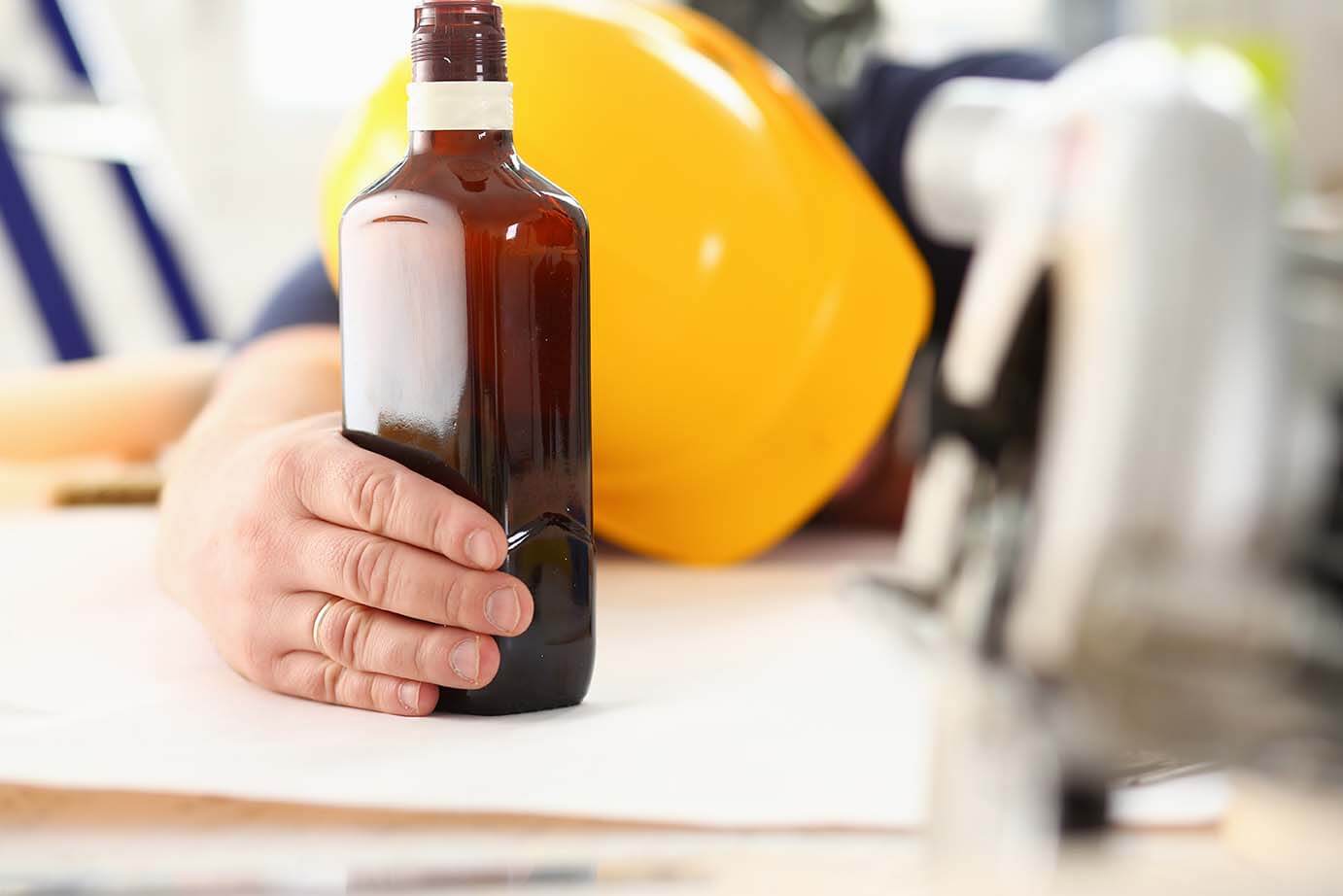
New Laws Spotlight Workplace Drug and Alcohol Management
With the introduction of the new laws, there is increased attention on the management of drugs and alcohol in the workplace.
Employers must have comprehensive plans in place to manage these substances effectively. This includes implementing drug and alcohol policies and procedures, providing education and training on the dangers of substance abuse, and conducting regular drug and alcohol testing.
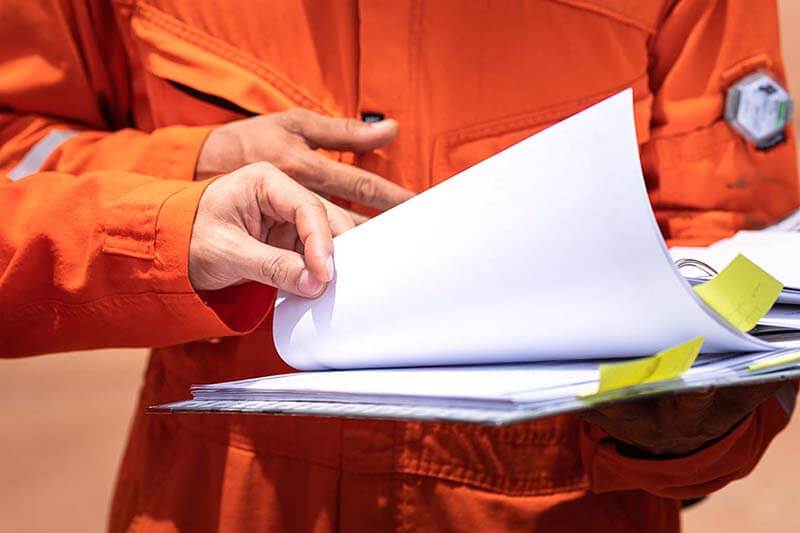
The Importance of Drug and Alcohol Policies and Procedures
One of the key aspects of managing drugs and alcohol in the workplace is having robust policies and procedures in place. These policies should outline the expectations and responsibilities of both the employer and employees regarding substance abuse. They should clearly state the consequences of violating the policy and provide guidelines for reporting any concerns related to drug or alcohol use.
By having clear policies and procedures, employers can establish a safe and healthy work environment. It ensures that all employees are aware of the rules regarding drugs and alcohol and understand the potential risks associated with their use.

Providing Education and Training on the Dangers of Substance Abuse
Education and training play a crucial role in creating awareness about the dangers of drug and alcohol abuse in the workplace. Employers should provide comprehensive training programs that highlight the potential risks, the impact on job performance and safety, and the legal implications of substance abuse.
Through education and training, employees gain a better understanding of the consequences of their actions and are more likely to make informed decisions regarding drug and alcohol use. It also helps to reduce stigma and encourages individuals to seek help if they are struggling with addiction.

The Role of Drug and Alcohol Testing
One of the most effective ways to ensure workplace safety and compliance with drug and alcohol policies is through regular testing. Drug and alcohol testing can help identify individuals who may be under the influence while on the job, reducing the risk of accidents, injuries, or fatalities.
There are various methods of drug and alcohol testing, including urine, oral fluid, hair and breathalyser tests. Each method has its advantages and limitations, and employers should choose the most appropriate method based on their specific needs and requirements.
By implementing regular drug and alcohol testing, employers send a strong message that the use of drugs and alcohol in the workplace is unacceptable. It acts as a deterrent and helps maintain a safe and productive work environment for all employees.
Discover More
Ask us how we can help your workplace comply with industrial manslaughter laws and ensure a safe and productive work environment.
